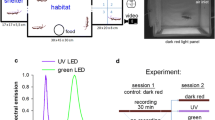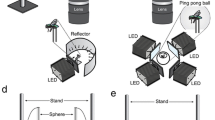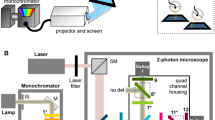Summary
A behavioural paradigm, the “fly balance” (Fig. 1), allows continuous recording of the position of a walking fly in a Plexiglas tube (Fig. 2). This apparatus was used to study elements of “slow” phototactic behaviour ofDrosophila melanogaster wildtype and some of its mutants. Lights of varying intensity and spectral composition were presented to the two ends of a Plexiglas tube (Fig. 3). The influence of the light stimuli on the walking behaviour and on the mean position of the flies relative to the light sources was evaluated.
If at both ends of the test tube strong UV-lights (375 nm) of equal intensity were presented simultaneously, the addition of visible light (λ>415 nm) at one end of the tube led to a preference of wildtype flies for the pure UV-light (Fig. 10). The “attractiveness” of a UV-light at one end of the tube was enhanced by a visible light present at the opposite end (Figs. 8, 9). These experiments are interpreted as demonstrating the perception of simultaneous colour contrast by flies.
In experiments where lights of different wavelengths were presented successively it became evident that the attraction towards UV-light was strongest shortly after switching from visible light (λ≧425 nm) to UV-light (Fig. 11 a, b). A 1 s exposure to visible light was sufficient to enhance subsequent attraction towards UV-light (Fig. 13). This adaptational effect of visible light was only observed at high UV-intensities (Fig. 14). In UV-light it decreased at a rate which was not positively correlated to the UV-intensity (Fig. 15). This phenomenon of successive contrast confirms the conclusion that UV-light and visible light are perceived as different colours byDrosophila melanogaster wildtype. The colour adaptation effects may enable the visual system of the fly to achieve some colour constancy. Selective adaptation at the photopigment level can be excluded as the sole origin of the described phenomena.
The data support the notion of photopic and scotopic vision being present in flies (Fig. 14), however, this distinctioncannot be accounted for by the photoreceptors alone. Mutants deficient in certain receptor types corroborate the idea that centraland peripheral retinula cells are functional under photopic light conditions (Figs. 6, 10, 14).
Similar content being viewed by others
Abbreviations
- PDA :
-
prolonged depolarizing afterpotential
References
Bicker, G., Reichert, H.: Visual learning in a photoreceptor mutant ofDrosophila melanogaster. J. comp. Physiol.127, 29–38 (1978)
Broda, H., Wright, R.: Prolonged depolarizing afterpotential in red eyedDrosophila. J. Insect Physiol.24, 681–684 (1978)
Fischbach, K.-F.: Funktionelle Differenzierung und Wechselwirkung der Rezeptorsysteme im Komplexauge vonDrosophila melanogaster. Dissertation, Freiburg (1976)
Fischbach, K.-F., Reichert, H.: Interactions of visual subsystems inDrosophila melanogaster: A behavioural genetic analysis. Biol. Behav.4, 305–317 (1978)
Fraenkel, G.S., Gunn, D.L.: The orientation of animals. Oxford: Oxford University Press 1940
Hardie, R.C.: Electrophysiological properties of R7 and R8 in Dipteran Retina. Z. Naturforsch.32c, 887–889 (1977)
Harris, W.A., Stark, W.S., Walker, J.A.: Genetic dissection of the photoreceptor system in the compound eye ofDrosophila melanogaster. J. Physiol. (Lond.)256, 415–439 (1976)
Heisenberg, M.: Comparative behavioral studies on two visual mutants ofDrosophila. J. comp. Physiol.80, 119–136 (1972)
Heisenberg, M., Buchner, E.: The rÔle of retinula cell types in visual behavior ofDrosophila melanogaster. J. comp. Physiol.117, 127–162 (1977)
Heisenberg, M., Götz, K.G.: The use of mutations for the partial degradation of vision inDrosophila melanogaster. J. comp. Physiol.98, 217–241 (1975)
Holst, E. von: Aktive Leistungen der menschlichen Gesichtswahrnehmung. Stud. Gen.10, 231–243 (1957)
Hu, K.G., Stark, W.S.: Specific receptor input into spectral preference inDrosophila. J. comp. Physiol.121, 241–252 (1977)
Jacob, K.G., Willmund, R., Folkers, E., Fischbach, K.F., Spatz, H.Ch.: T-maze phototaxis ofDrosophila melanogaster and several mutants in the visual systems. J. comp. Physiol.116, 209–225 (1977)
Kirschfeld, K., Feiler, R., Franceschini, N.: A photostable pigment within the rhabdomere of fly photoreceptors No. 7. J. comp. Physiol.125, 275–284 (1978)
Kirschfeld, K., Lutz, B.: Lateral inhibition in the compound eye of the flyMusca. Z. Naturforsch.29c, 95–97 (1974)
Kirschfeld, K., Lutz, B.: The spectral sensitivity of the ocelli ofCalliphora (Diptera). Z. Naturforsch.32c, 439–441 (1977)
McEwen, R.S.: The reaction to light and gravity inDrosophila and its mutants. J. Exp. Zool.25, 49–106 (1918)
Médioni, J.: Contribution à l'étude psychophysiologique et génétique du phototropisme d'un insecteDrosophila melanogaster. Thèse Fac. Sci., Université Strasbourg, No. 203 Sér. E11–157 (1961)
Menne, D., Spatz, H.Ch.: Color vision inDrosophila melanogaster. J. comp. Physiol.114, 301–312 (1977)
Minke, B., Wu, C.F., Pak, W.C.: Isolation of light induced response of the central retinula cells from the electroretinogram ofDrosophila. J. comp. Physiol.98, 345–355 (1975)
Ostroy, S.E., Wilson, M., Pak, W.L.:Drosophila rhodopsin: photochemistry, extraction and differences in the norp AP12 phototransduction mutant. Biochem. Biophys. Res. Commun.59, 960–966 (1974)
Pak, W.L., Lidington, K.J.: Fast electrical potential from a long lived, long-wavelength photoproduct of fly visual pigment. J. Gen. Physiol.63, 740–756 (1974)
Poggio, T., Reichardt, W.: Visual control of orientation behaviour in the fly. Q. Rev. Biophys.9, 377–433 (1976)
Reichert, H.: Verhaltensgenetische Untersuchungen zur Funktionsweise der dorsalen Ozellen beiDrosophila melanogaster. Thesis, Freiburg (1976)
Schümperli, R.A.: Evidence for colour vision inDrosophila melanogaster through spontaneous phototactic choice behaviour. J. comp. Physiol.86, 77–94 (1973)
Smola, U., Meffert, P.: Die spektrale Empfindlichkeit der zentralen Sehzellen im Auge der Schmei\fliegeCalliphora erythrocephala. Verh. Dtsch. Zool. Ges.1976, 282 (1976)
Stark, W.S.: Sensitivity and adaptation in R7, an ultraviolet photoreceptor, in theDrosophila Retina. J. comp. Physiol.115, 47–59 (1977)
Willmund, R., Fischbach, K.-F.: Light induced modification of phototactic behaviour ofDrosophila melanogaster wildtype and some mutants in the visual system. J. comp. Physiol.118, 261–271 (1977)
Author information
Authors and Affiliations
Additional information
The “slow” phototaxis apparatus and the “fly balance” were kindly provided for the experiments by the Max-Planck-Institut für biologische Kybernetik, Tübingen. The work was supported with suggestions, instruments and critical comments on the manuscript by Prof. M. Heisenberg. I am further indebted to Drs. J. Blondeau, W.S. Stark, P. Towner, Chr. Wehrhahn, R. Wright, and in particular to Prof. H.Ch. Spatz, who read the manuscript and made valuable comments.
Rights and permissions
About this article
Cite this article
Fischbach, K.F. Simultaneous and successive colour contrast expressed in “slow” phototactic behaviour of walkingDrosophila melanogaster . J. Comp. Physiol. 130, 161–171 (1979). https://doi.org/10.1007/BF00611050
Accepted:
Issue Date:
DOI: https://doi.org/10.1007/BF00611050




